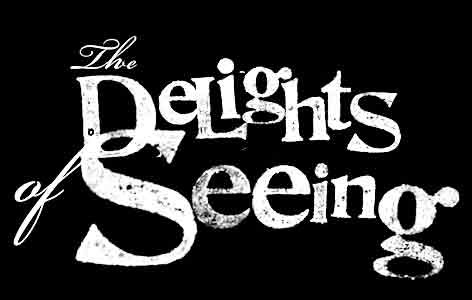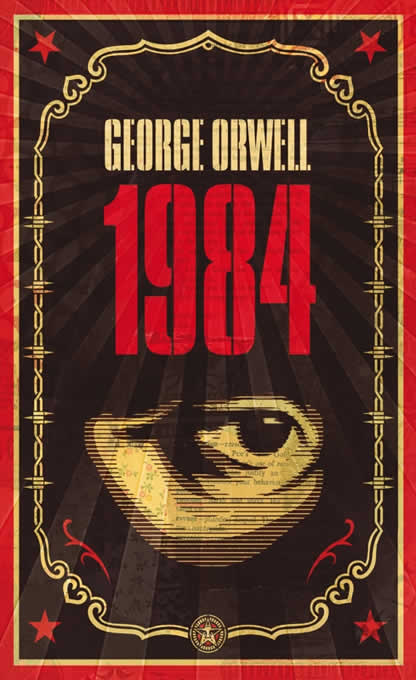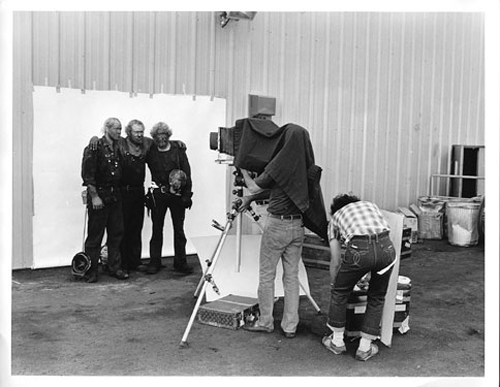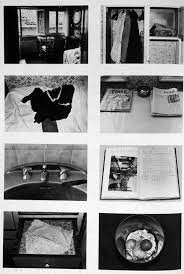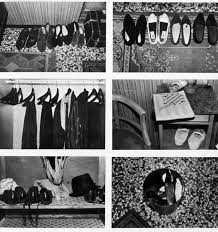In 1948 George Orwell wrote a book about Winston Smith who worked as a clerk in the record department of the Ministry for Truth. One of the key themes is surveillance - Winston is always being watched at work, on the street and at Home. The language of 1984 has seeped into are common language from 'Newspeak' To 'Big Brother is Watching You'. Modern Britain is covered in CCTV camera and a Government Information Commissioner (sounds slightly Orwellian) has described Britain as a Surveillance Society.
Walker Evans 'Subway Portraits'
In the 1930s Evans photographed passengers in the New Yorker Subway. Using a 35mm camera hidden under his coat he captured the person opposite unobserved. This selection of portraits of women, intended for an earlier unpublished version of 'Many Are Called' which Evans called 'The Passengers (Hidden Camera in the New York Subway)', was compiled around 1961. Sarah Greenough said of The Passengers: "[It] emphasizes the mug-shot-like quality of some of the photographs". The complex work of Walker Evans combines confronting the surveillance and depicting process used by the police with other aspects – such as generating the anonymous in the realm of modern urban life.
In Victorian Britain they didn't have the Internet, televisions or package holidays. If you wanted to experience foreign lands you could look at Stereoviews from around the world. Photography had the ability to transport you to another place or time. John Thomson's images of China and South-East Asia brought the land, culture, and people of the Far East alive for the 'armchair travellers' of Victorian Britain.
He was one of the pioneers of photojournalism, using his camera to record life on London's streets in the 1870s. As a society photographer he also captured the rich and famous in the years before the First World War
In this image of a married couple from Xiamen, a port city in south-eastern China, the husband is looking away because at the time it was thought improper for a couple to face each other. Tomson's photographs are fascinating but are they purely informative or are they intrusive. Tomson came from Victorian Britain and an imperial mentality. Are these images voyeuristic - are we just staring. A camera by its very nature is a clinical device staring at the world and capturing it in detail. Have you ever had a photograph taken of yourself and wanted the image torn up or deleted. The chances are you have and you would feel less like this if it was a drawing - a drawing is an interpretation whereas a photograph, seems at least, is you. It is only light reflected off you and caught in a box but it seems more than this. Images have power.
'Ronald Fischer - In the American West' (1981) Richard Avedon
Laura Wilson - Avedon at work
Richard Avedon was a fashion photographer and a main criticism of his work is that it is shallow - like fashion there is only the surface. Avedon would argue in photography there is only surface - it is all you have got. One of his key trade marks was photographing people against a stark white background - the same approach for everybody. A white sheet, stuck against a wall, using outside light was his approach for 'In the American West'. Avedon's cold gaze you are exposed - his images are not about the subject but they are about Avedon's own philosophies.
Richard Billingham 'Ray's a laugh' 1997
A cat flies through the air, a moves back in shock - the whole scene is captured in grainy cheap shop colour.
Portrait of Salvador Dali by Philippe Halsman
The first image shares a similar quality to this image. The Surrealists were fascinated by the world of our dreams and the juxtapositions that took place in them. Salvador Dali created strange images were clocks melted, forms were distorted, solid object became liquid and gravity didn't play by the rules of physics. In this image by Philippe Halsman, Dali's world seems to have been recreated with a chair floating in the air, flying cats and solid water. in reality a man (out of shot on the left hand side) hold the chair up, another person throws a bucket of water creating a flow, Dali jumps and two unsuspecting cats are thrown through the air.
Richard Billingham 'Ray's a laugh' 1997
A lady lies diagonally across a sofa - breaking the composition up into two triangles. Her highly decorative dress jumps out against the dull brown sheen of the sofa but is mirrored in the patterned wall paper above her head. The line between the cushions on the sofa create a line going vertically up the centre of the composition.
Titian, 'Venus of Urbino', Oil on Canvas 1538.
A lady lies diagonally across a bed, a curtain goes up vertically creating a line through the centre of the image.
Manet 'Olympia' 1863
Manet's 'Olympia' was a subversive take on Titian's 'Venus of Urbino' that caused controversy when it was first shown.
Amedee Cantaloube writes in Le Grand Journal, June 22nd, 1865:
“This Olympia is a sort of female gorilla, a grotesque in India rubber outlined in black, apes on a bed, in a state of complete nudity, the horizontal attitude of Titian’s Venus: the right arm rests on the body in the same fashion, except for the hand, which is flexed in a sort of shameless contraction.”
Billingham's photograph does bare a passing resemblance to these two famous paintings.
Billingham, Richard began making photographs of his family—mother, father, and younger brother—as studies for paintings while still a student at Sunderland University. The photographs show lives troubled by drugs, violence, and neglect, yet tempered with affection. His work appeared in the Who's Looking at the Family exhibition at the Barbican Gallery, London, in 1994, and drew worldwide attention as part of Sensation: Young British Artists in the Saatchi Collection in 1998. The images have an amateur quality but also an earthy realness and in the haphazard framing there also seems to be several reference to art. These are Billinham's family - the people he loves most in the world. Yet by turning his camera on them he becomes an observer in his own home - the camera judges. He has become a voyeur.
This series of photographs were released in a book and have appeared in international exhibitions at major galleries. When they are viewed in galleries they are viewed by strangers and the type of people who look at art. More often than not these people do not come from council estates like Billingham - Billingham's home life appears exotic to these people. Is the success of these image due to their documentary nature or the voyeur inside us all - wanting to stare - needing to judge.
Sophie Calle 'The Hotel'
Sophie Calle became a cleaner so she could get into people’s hotel rooms. In the series she photographs a room, photographs their personal items and mentions if they have been moved and writes a diary throughout the guests’ stay, deducing what she can about them by what they leave in their rooms e.g."Room 25 “ Thursday 19. Noon. He is gone. He has left his orange peels in the wastebasket. Three fresh eggs on the windowsill, and remains of a croissant which I polish off. I shall, miss him."
The photographs made you feel as if you had sneaked into the people’s rooms too and might be caught out at any moment. Calle's work was included in Tate Modern's 'Exposed' exhibition. The exhibition was looking at the issue of voyeurism and how it has played a role in photography. It makes you consider the intrusive role that photography and surveillance can play in our society. Exposed looked at pictures made secretly, without people's permission, from the 19th century to the present day. Photographs gave a shocking, illuminating and witty perspective on iconic and taboo subjects.
These image are by the contemporary photographer David Birkin from his 'Confessions' series. The subject is asked to confess a secret they have never previously revealed. They are then left alone in a room facing a camera. When they feel ready, they open the shutter and when they are finished they close it. Each exposure is determined by the length of the confession. The confession remains a mystery to the viewer but every gesture, squirm and nervous tick is captured on the photograph.
Birkin's images have a Bacon-esque quality - especially when viewed next to bacons portraits of lone figures framed by his trade mark claustrophobic box.
Birkin's 'Confessions' series is reminiscent of Andy Warhol's 'Screen Tests'. Warhol would invite people to The Factory and sit them in front of a single light. He would then film them with a 16 mm film camera for the length of the reel (about three minutes). When he played these films back (often projected in a gallery) he set it to a slower speed - this way every gesture would be magnified. Initially the subject would try to retain the mask they showed the world but eventually little glimpses of the real person would appear. As with several of the references here this is not a slow shutter speed but the screen tests do document the passing of time. A still image is not time based - you can go back to it again and again (often over a lifetime). A film is Time Based and it has a beginning, a middle and an end - you read it differently. Still images can burn their way into your mind - even parts of films or your life are remembered like still images when they are recalled.
